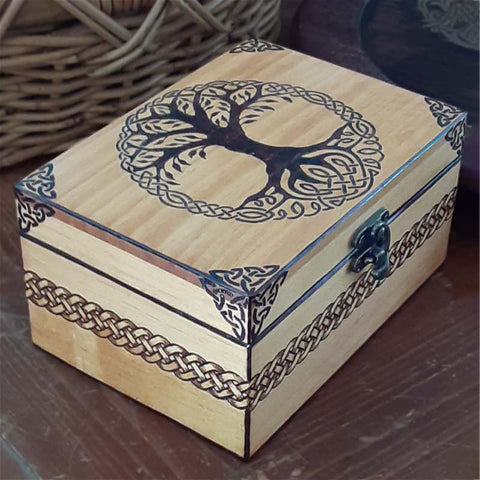How to Choose the Best Wood for Engraving?
When starting a wood engraving project, one of the most important choices you'll make is the type of wood you’ll use. While it may seem like a small detail, the wood you choose can make or break the final result. Different types of wood respond differently to engraving techniques—some burn smoothly and cleanly, while others may splinter, char too easily, or absorb the design unevenly.
Whether you're using a laser engraver or a pyrography tool, the wood’s grain, density, and color all play key roles in how the finished piece turns out. If you're wondering what wood is best for engraving, you're in the right place. This guide will walk you through the key factors to consider and introduce you to the top types of wood used for engraving. Let’s dive in!

Key Factors to Consider When Choosing Wood for Engraving
1. Grain Structure
The grain of a wood refers to the pattern and direction of its natural fibers. Fine-grained woods—such as basswood and maple—offer smoother surfaces that allow engravers to achieve cleaner lines and intricate detail. Coarse-grained woods like oak can interrupt the flow of a design, leading to uneven textures and shadows. Uniform grain is ideal for both hand and laser engraving.
2. Wood Hardness
Measured by the Janka hardness scale, a wood's density affects how it responds to tools. Softer woods (like basswood or alder) are easier to engrave, especially for pyrography, but they can dent or chip if handled too roughly. Hardwoods (like maple and walnut) require more power or pressure but provide crisp, lasting results. Finding the right balance between softness and structural integrity is essential.
3. Resin and Oil Content
Some woods, like pine or cedar, have high resin or oil content. These substances can interfere with engraving by causing inconsistent burning, producing sticky residue, or clogging laser nozzles. Low-resin woods, such as birch or cherry, ensure a cleaner, more predictable burn.
4. Color and Contrast
Lighter woods make engraving details more visible, particularly with laser tools that darken the surface. Woods like basswood, birch, and alder offer a pale canvas that highlights engraved lines with strong contrast. Darker woods like walnut can produce elegant, subtle results—but require precise control for the engraving to stand out.
5. Surface Finish
Unfinished, sanded wood is always preferred. Coated or varnished surfaces can reflect heat unpredictably, leading to poor results or even smoke and scorch marks. Always use clean, untreated wood for best outcomes.
6. Cost and Availability
While exotic hardwoods may be beautiful, they’re often expensive and harder to find. Beginners are better off practicing on affordable, easy-to-source options like basswood or birch before moving on to pricier species.
Best Types of Wood for Engraving
- Basswood
This is often considered the go-to wood for engraving. Its pale cream color and ultra-fine grain make it perfect for detailed work. It burns evenly and is very soft, making it ideal for beginners using pyrography pens or low-power lasers. Basswood is also widely available and budget-friendly.

- Maple (Hard and Soft)
Maple comes in two primary forms: hard and soft. Both have a tight, smooth grain and a light tone that contrasts beautifully with dark burn marks. Hard maple is more durable and ideal for professional projects, while soft maple is easier to work with and more forgiving for hobbyists.
- Cherry
Known for its reddish-brown hue, cherry engraves beautifully with rich, dark lines. It darkens naturally over time, giving projects a deep, elegant patina. Its fine, straight grain makes it suitable for detailed laser work, though it may require slightly higher heat than softer woods.
- Birch (Baltic Birch Plywood included)
Birch offers a nice balance of softness and durability. It has a consistent grain and light color, making it easy to engrave and visually striking. Baltic birch plywood is a popular choice for sign makers and crafters due to its stability and clean layering.

- Alder
Alder is a soft hardwood with a consistent, low-resin grain. It engraves smoothly and darkens evenly under heat, producing high-contrast results. Its reddish undertone adds warmth to any design, and it’s particularly favored in laser engraving circles for its predictable performance.

- Walnut
Deep brown and richly textured, walnut is a premium choice for high-end engraved products. Its density means it resists damage and wears well over time, but it also requires more powerful tools. The contrast isn't as stark as with lighter woods, but the elegance is undeniable—ideal for heirloom pieces or luxury gifts.

- Pine (with caution)
While affordable and easy to find, pine is a softwood with high resin content. It can result in uneven burning and sticky residue, especially under laser heat. That said, with careful preparation and test burns, pine can be used for rustic or distressed-style pieces.
Wood Engraving Project Ideas (Internal Links to Follow):



Ready to Begin?
Choosing the right wood is just the beginning of your engraving journey. If you're feeling inspired but still learning the ropes, don’t miss our full Beginner’s Guide to Wood Engraving. It covers everything from tools to safety tips—perfect for turning your next idea into a beautifully crafted piece.


